Pan-fried flat dumplings filled with fragrant Chinese chives, tender eggs, and springy noodles — Chinese chive pockets are simply delightful.
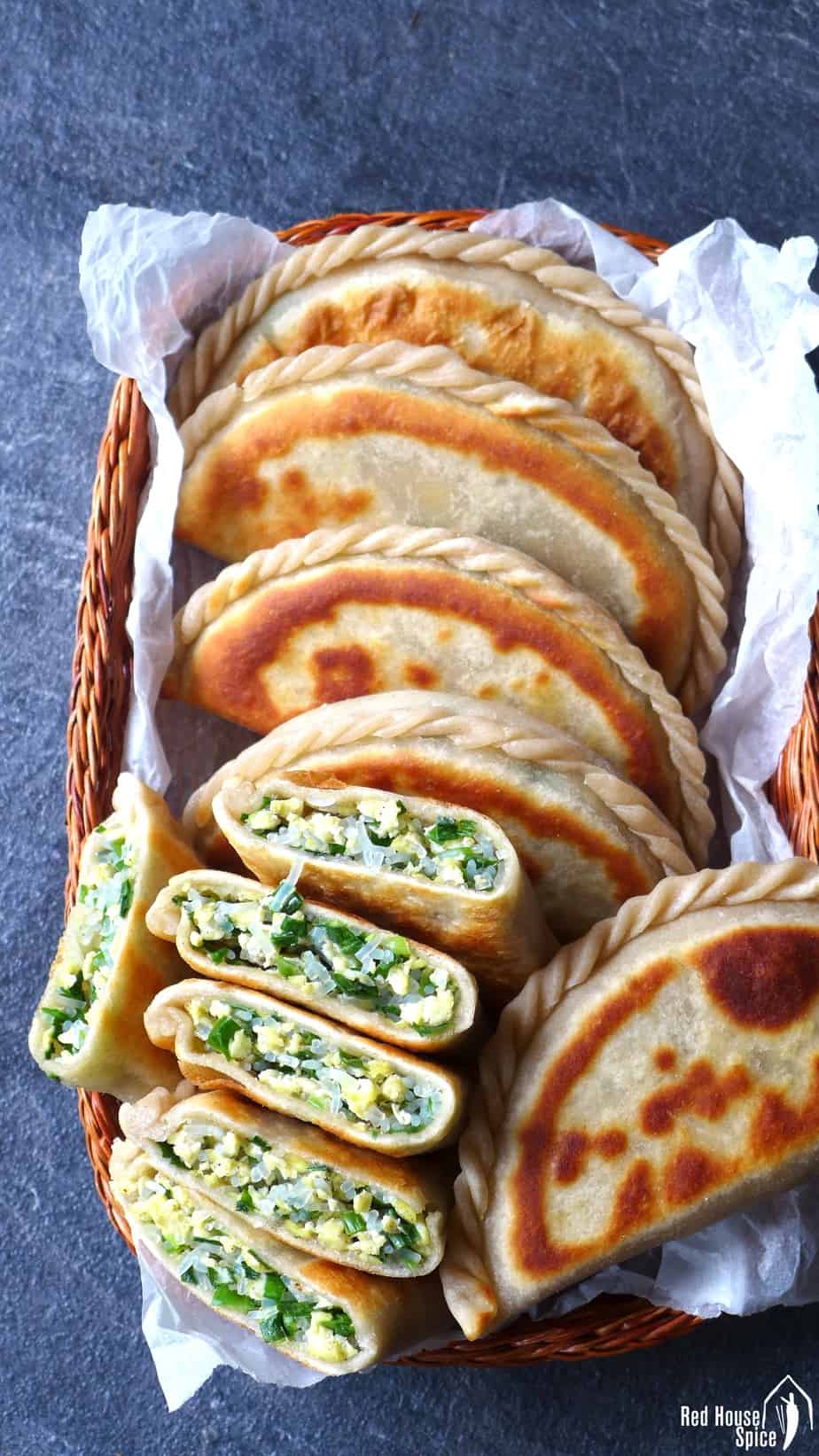
Flour-based dishes with meat filling, such as dumplings, buns, stuffed flatbread, etc., were nominated to be our family’s favorite type of food. Last week, after we happily tucked into some Chinese chive pockets (Jiu Cai He Zi/韭菜盒子), I was reminded so much of my childhood and how much I love vegetarian fillings—just as much as if not more than, meat-based fillings.
Jump to:
What are Chinese chive pockets
Chinese chive pockets are pan fried, semi-circle shaped, flat dumplings filled with Chinese chives and scrambled eggs. Sometimes you can find mung bean vermicelli noodles in the filling. Chinese chives have such a strong and appealing flavour on its own that you don’t need to add too much seasoning to the filling.
Chinese chives (aka garlic chives, Jiu Cai/韭菜) have long, flat, dark green leaves. They not only look different from regular chives but also have a much stronger flavor, resembling the taste of garlic—less pungent but more fragrant.
In Chinese cuisine, they are usually used as a vegetable (rather than a herb) and often paired with meat or eggs, such as Pork and Chive Dumplings, Stir-Fried Chive and Egg. Among many dishes that feature this flavourful vegetable, Chinese chive pocket (韭菜盒子), literally means “Chinese chive box”, is no doubt the most popular one.
You may find Chinese chive pockets complicated at first glance. However, they are actually much easier to make than you would imagine.
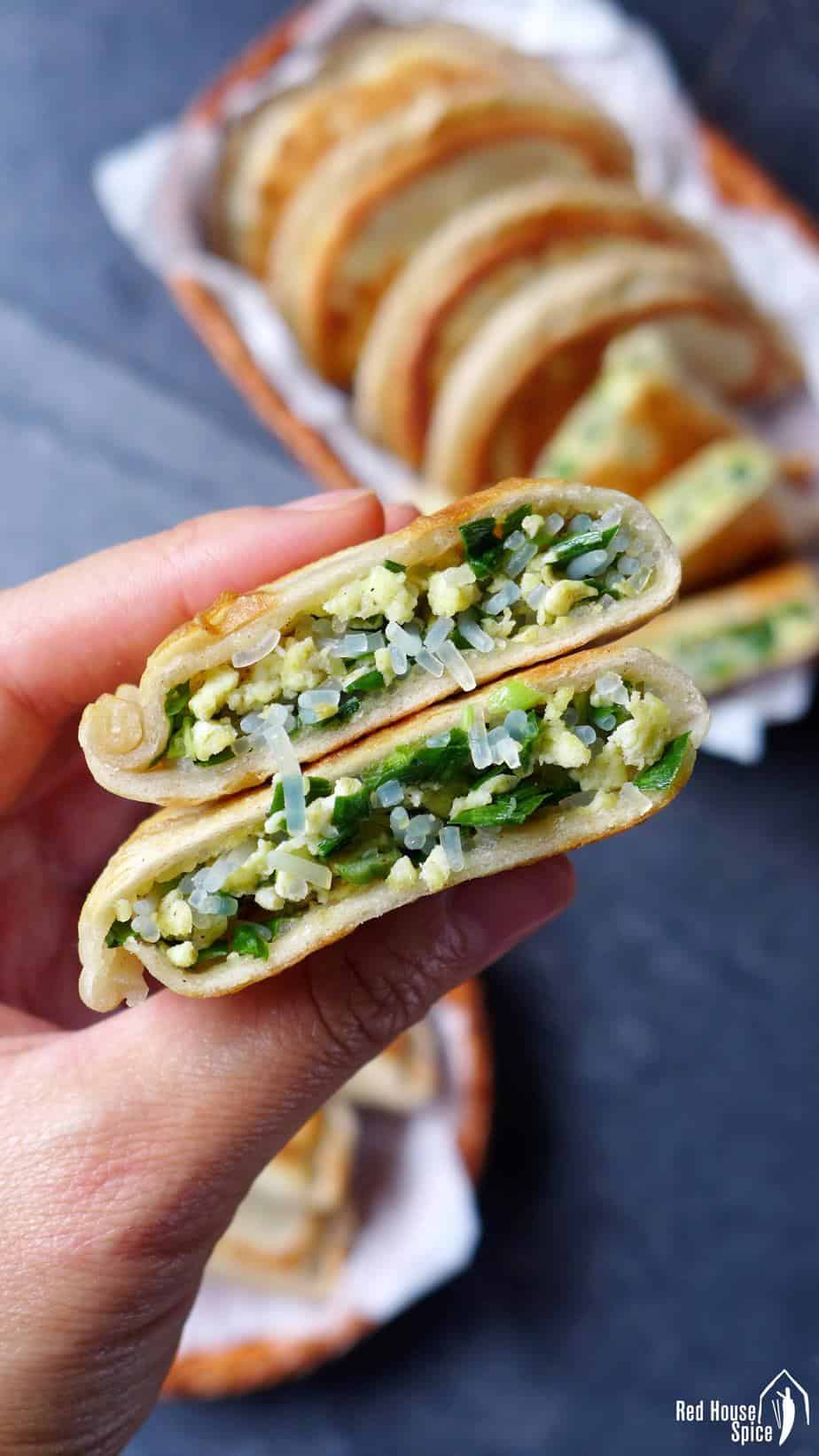
Prepare the dough
You only need two things for the dough:
- All purpose flour
- Hot water
Different from regular dumpling dough, which calls for room-temperature water, the classic version of chive pockets uses hot water. This approach makes the dough softer, less chewy, and shortens the cooking time.
Here is how you make the dough:
- If using a stand mixer: Add the flour and hot water to the mixing bowl. Use the dough hook to mix on low speed for about 8 minutes, until a soft, cohesive dough forms. Briefly knead it by hand until it becomes smooth.
- If kneading by hand: Place the flour into a heat-proof bowl, then pour the hot water over it while stirring with chopsticks or a fork to form lumps. Let the mixture sit for a short while. As soon as it’s cool enough to handle, combine and knead by hand to form a soft, smooth dough.
Without delay, cover the dough tightly with cling film to prevent it from drying out. Let it rest for about 15 minutes while you prepare the filling.
🌟 NOTE: Since hot water evaporates quickly, it’s important to mix and knead the dough without delay. Otherwise, the dough may dry out.
Make the filling

The filling for these pockets calls for these ingredients:
- Chinese chives
- Eggs
- Mung bean vermicelli, optional (see note below)
- Salt
- Ground Sichuan pepper, or five spice powder, ground white pepper
- Neutral cooking oil
🌟 NOTE: Mung bean vermicelli noodles don’t have much flavor on their own, but they offer an interesting texture and help absorb excess moisture in the filling. You may skip them if they are unavailable. In that case, increase the amount of chives and eggs accordingly.
To prepare the filling, you’ll need to follow these steps:
- Scramble the lightly beaten eggs in hot oil, then chop them into small pieces.
- Rehydrate the dried mung bean vermicelli noodles by soaking them in hot water for 5 minutes until they become pliable. Then, chop them into very short strands.
- Add the finely chopped Chinese chives, noodles, eggs, and all the seasonings to a bowl. Mix well.
Shape the pockets

You can shape these chive pockets using the simplest method (see image above):
- Place the filling in the middle of the wrapper
- Flip one side of the wrapper towards the other
- Seal the edge by pinching between your thumb and index finger

If you’d like to create a more attractive pattern as shown in the images above, watch the tutorial video in my post on Ten ways to fold dumplings.
🛎 NOTE: I don’t recommend using pre-made, commercial dumpling wrappers to make Chinese chive pockets. They are too small and too thin, making them unsuitable for this recipe.
Pan-fry the pockets
Use a large skillet to fry these chive pockets. They take less time to cook than regular dumplings (e.g., Pan-Fried Kimchi Dumplings) because the dough is partially ‘cooked’ by hot water, and the vegetarian filling cooks through more easily.
- First, add a little oil to the skillet—just enough to coat the surface—and set it over medium heat.
- Lay the chive pockets in the skillet, then cover with a lid. Wait until the bottom side turns golden.
- Flip the pockets over to fry the other side without the lid. Enjoy them while warm, with a dip in Chinese Chili Oil if you like.
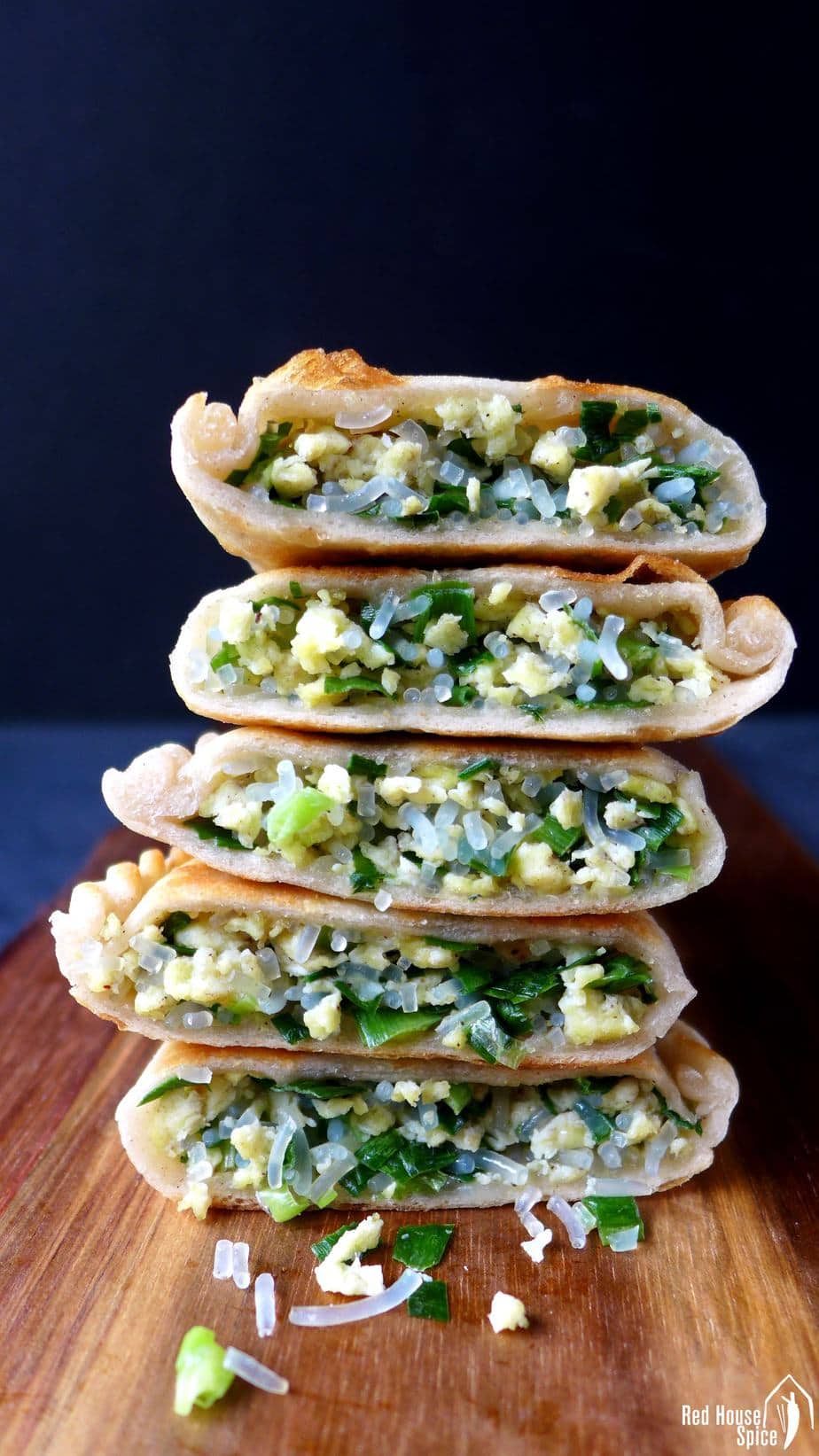
Make ahead
Chinese chive pockets are a great food to make in advance. The method is the same as how you store regular dumplings for later use.
- Freeze uncooked chive pockets on a lightly floured tray. Once completely frozen, transfer them to an airtight bag and store in the freezer for up to three months.
- Fry the frozen pockets without defrosting them first. When frying the first side, add about ½ cup (120 ml) of water and cover the pan with a lid. The steam will help cook them through evenly.
Substitute
Although Chinese chives are widely available in Asian or Chinese shops, in springtime, I like using Wild garlic (aka Ramsons) as a substitute. Growing in woodlands, it belongs to the Allium family and has a flavor very similar to Chinese chives. If you search for “where to find wild garlic” on Google, you might discover a few locations near you. Good luck!
Other vegetarian dishes
Looking for more vegetarian-friendly recipes? Check out these popular ones:
📋Recipe card
Love this recipe? Please leave a 🌟🌟🌟🌟🌟 rating and a comment. Thank you!
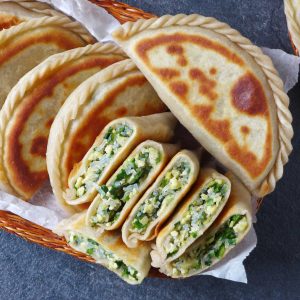
Chinese chive pockets (韭菜盒子)
Ingredients
For the dough
- 3 cup all-purpose flour - plus a little extra for dusting
- 1 cup hot water
For the filling
- 4 eggs - lightly beaten
- 1 bundle dried mung bean vermicelli - 1.8 oz/50 g, optional, see note 1
- 6 oz Chinese chives - finely chopped
- 3 tablespoon neutral cooking oil
- 1 teaspoon salt
- ¼ teaspoon ground Sichuan pepper - or five-spice powder, ground white pepper
For frying
- 2 tablespoon neutral cooking oil
Instructions
Make the dough
- Put the flour into a heatproof bowl. Pour in hot water (soon after being boiled). Stir with chopsticks or a fork until the flour turns into small lumps.
- As soon as the mixture becomes cool enough to handle, knead the mixture into a soft, smooth dough (see note 2).
- Cover the dough tightly with cling film. Leave to rest for 15 minutes.
Prepare the filling
- Heat oil in a skillet over high heat until very hot. Pour in the beaten eggs and scramble until they turn solid. Once they cool down a little, chop into small pieces.
- Soak mung bean vermicelli in hot water for 5 minutes until pliable. Rinse under cold water, then chop the strands into tiny pieces.
- Put the chopped chives, vermicelli and eggs into a mixing bowl. Stir in salt and ground Sichuan pepper (or five-spice powder, ground white pepper).
Assemble the pockets
- Divide the dough into 12 equal portions.
- Dust the working surface and the rolling pin with a little flour to prevent sticking. Flatten each piece of dough into a round wrapper, about 6 in / 15 cm in diameter.
- Place the filling mixture in the middle of a wrapper then seal it into a semi-circle flat pocket (see note 3)
Fry the pockets
- Fry the assembled pockets in two batches. Pour 1 tablespoon of oil into the skillet over medium heat.
- Place in 6 chive pockets then cover with a lid. Flip over when the first side becomes golden brown.
- Fry the other side uncovered until it turns golden brown (see note 4).
Make ahead
- Freeze uncooked chive pockets on a lightly floured tray. Once completely frozen, transfer them to an airtight bag and store in the freezer for up to three months.
- Fry the frozen pockets without defrosting them first. When frying the first side, add about ½ cup (120 ml) of water and cover the pan with a lid.
NOTES
NUTRITION
NUTRITION DISCLOSURE: Nutritional information on this website is provided as a courtesy to readers. It should be considered estimates. Please use your own brand nutritional values or your preferred nutrition calculator to double check against our estimates.


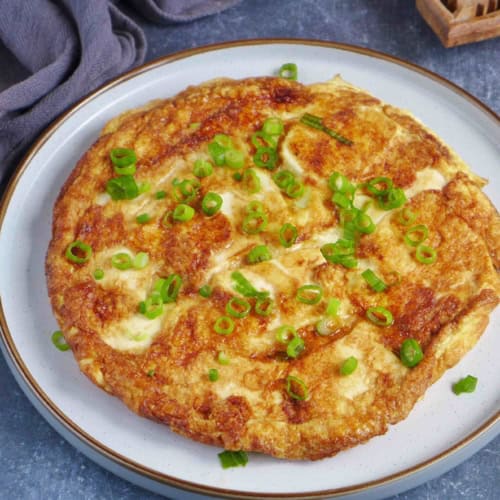
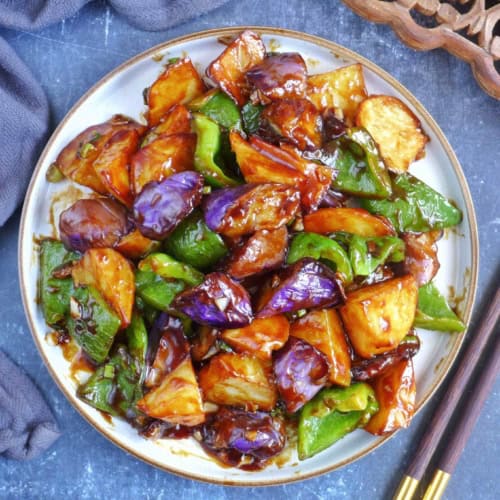
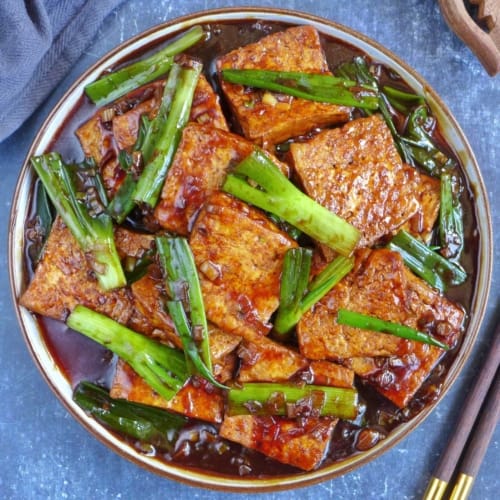
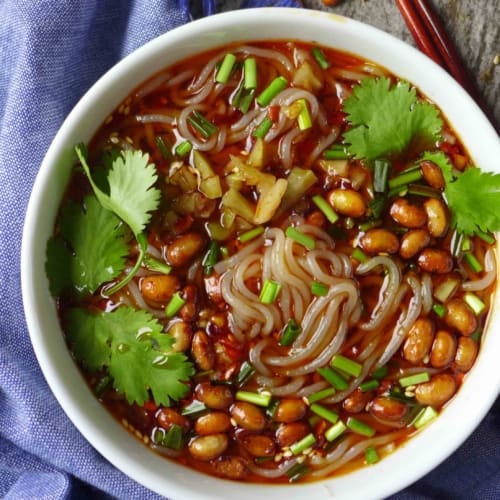
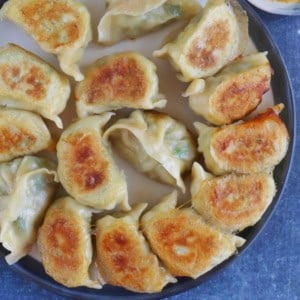
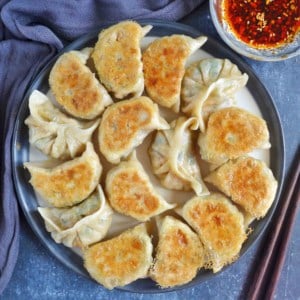
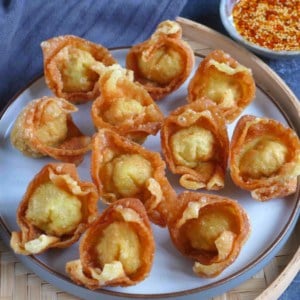
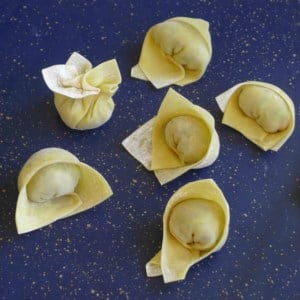
Are there best surveys hot, cold, or room temp?
It’s best to enjoy them while warm.
hi what dipping sauce would you pair with this?
My favourite is a simple combination of black rice vinegar and homemade chilli oil. Otherwise, have a look at my post on Dumpling Sauces.
thank you for the recipe, they are really delicious😋 one question though, I bought a pack of Chinese chives to try different recipes, but I do not cook every day Chinese, so do you think I can freeze it? (cutting before of course..) since they sell it in a huge amount and won’t use it all in once.
Hi Simo! Happy to know you’ve enjoyed these pockets. You could freeze Chinese chives but they won’t be good for stir-fry dishes in which you clearly see each ingredient (defrosted chives don’t look great). That said, it’s perfectly fine to chop them small and freeze in small portions for making fillings later on. Hope this helps.
Hi Wei,
Just a quick question: can the dough be made in advance and kept in the refrigerator overnight in a ziploc bag? Or does it need to be made the same day it is stuffed?
You could do that Shatara. Make sure you bring the dough back to room temperature before working on it.
What is the alternative to frying? Can it be baked, as well? If so, what temperature do you reckon and for how long?
Rob
These pockets won’t come out very nice when baked as the dough is not leavened. If you like the filling and wish to bake, have a look at my post “Baked Bao Bun with Lamb“. You can replace the filling with this egg & Chinese chive combination.
Hi Wei!
I made this recipe tonight and I was delighted, as well as my boyfriend even though he is not quite acquainted to authentic Chinese cuisine. I was so happy he liked it, because I will surely make some again.
🙂
I can’t wait to venture further on your site and try some of your other delicious recipes.
xiè xie and zài jiàn
Nathalie
You are welcome Nathalie! Very happy to know you enjoyed it! Stay safe & cook more delicious food!
What is teh protein content of the flour used? The all purpose flour in the United States has a different protein content than that sold in Europe and I wouldn’t want the dumplings to be tough.
Hi Mel! Flour with medium gluten level works well, 10-11g protein per 100g flour. Hope this helps.
Wei, I just tried your recipe for chives pocket and it was good and easy to follow. Your pictures and explanations were helpful. It was successful. Will try your other recipes. Thank you and God bless.
You are welcome Tina. Very happy to know you enjoy using my recipe. Happy cooking!
Correction: How would THEY handle being frozen?
Hi!
I’ve used this recipe before and added fresh shrimp and it turned out great. I was wondering if I wanted to add pork and shrimp, do you think the results would still taste good? I enjoy the vegetarian version but my boyfriend really likes meat haha, thanks for your time!
It’s perfectly fine to mix Chinese chives with pork and shrimp (that’s a classic combination). Happy cooking!
These look fabulous. How would the handle being frozen?
Thank you for popping by! You can surely freeze uncooked pockets. Fry them without defrosting. Just make sure to add about 1/2 cup of water then cover with a lid when you fry the first side. The steam will help to cook through. Have a great time in your kitchen!